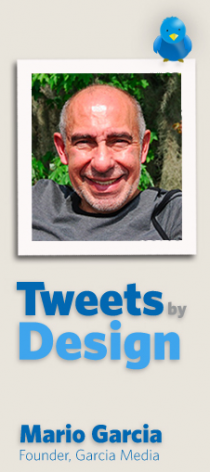TAKEAWAY: It’s called citizen journalism by many, it is referred to as crowdsourcing by marketing experts. Welcome to the new world of reporting the news. PLUS: Pure Design download: spatial relationship between items on a page.
Everyone’s a journalist—or a photographer
It becomes more obvious each day. You are watching CNN(see CNN”s iReport.com, where the stories come directly from users of the site) , or any other TV broadcasting channel, for that matter, and within minutes, you will see video contributed by some viewer who happened to be there when the first signs of the hurricane hit the shore, not to mention the “galleries of photos” sent in by readers to newspapers worldwide after a breaking news event.
In journalistic circles, it is always described as participatory or citizens’ journalism. Another term for it is crowdsourcing: you take a task ordinarily performed by a professional employee and you outsource it online to a crowd of enthusiasts to an open call invitation to participate.
Because there is a photographer, videographer or journalist in almost everyone of us, and because the current technology allows it, then the task becomes easier. As a result, citizens’ journalism is on the rise. This is, of course, a benefit for media companies, which can not only save money, but also provide their audiences with images and stories that perhaps reporters and photographers could not get to.
When a jetliner landed on the Hudson River in January, some of the best images we saw early on were taken by witnesses at the scene.
Perhaps one of the best current examples of crowdsourcing may be Wikipedia, with contributions coming entirely by the audience to which it caters. However, the term crowdsourcing was coined by Wired Magazine‘s journalist Jeff Howe in 2006, although experts that the concept dates back to the 18th century when early editions of The Oxford English Dictionary were crowdsourced by volunteer contributors sending in definitions on paper slips.
I am personally fascinated by discussions of crowdsourcing which I admit are becoming more common in newsrooms globally. Perhaps the first internal step towards crowdsourcing in newspapers and magazines is the fact that now reporters are armed with photo and viceo cameras to take on assignments (something that understandibly does not sit well with photographers in the newsroom who see their jobs threatened).
For a video about crowdsourcing and news go here:
Pure Design download: Relationships between items
The Impact of the Compact
Pure Design: Download entire section: Type
Download entire first section of Pure Design: Words
Now that I have fully presented the first of six sections of Pure Design on TheMarioBlog, I am offering the entire initial section, “Words,” available for download—all 33 pages of it. This may be useful for those of you saving or printing out Pure Design and will be done following each of the remaining sections. At the end of our journey through words, type, layout, color, pictures, and process, I will publish the entirety of Pure Design in one file.

Who is Jacky?
Jacky belongs to Frank Deville. The Luxembourg-based pooch is an “avid reader” of the German newspaper, Bild Am Sonntag. Every Sunday Jacky picks stories and interesting graphics in Bild Am Sonntag , the German newspaper.
WAN’s World Trends 2009 Report

The 2009 edition of World Press Trends from WAN/IFRA is now available. I always like to review this report for its complete information on global circulation, advertising and online trends in our industry. All countries in the world where daily newspapers are published are covered in the publication.
This year the WAN/IFRA folks have decided to publish a print version but only make the book available on pdf.
Those interested go:
http://www.wan-press.org/forms/wpt2009.html

Follow me at www.twitter.com/tweetsbydesign
Follow the Marios

Two Marios. Two Views.
Follow Mario Jr. and his blog about media analysis, web design and assorted topics related to the current state of our industry.
http://garciainteractive.com/
Visit Mario Sr. daily here, or through TweetsByDesign (www.twitter.com/tweetsbydesign)
In Spanish daily: The Rodrigo Fino blog
:
To read TheRodrigoFino blog, in Spanish, go:
https://garciamedia.com/latinamerica/blog/
TheMarioBlog posting #341